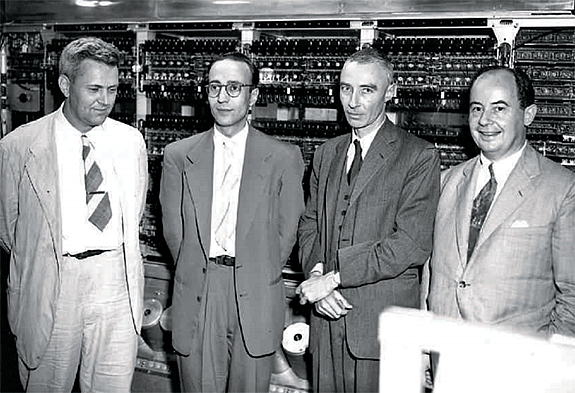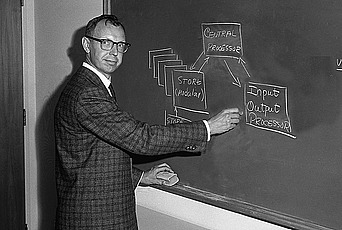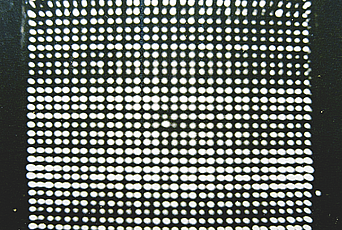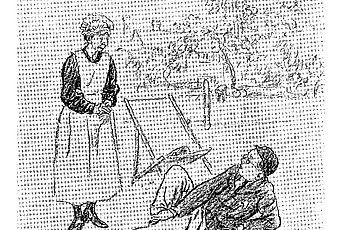Julian Bigelow: Bridging Abstract Logic and Practical Machines

Julian Himely Bigelow, who joined the IAS Electronic Computer Project as Chief Engineer in March of 1946, was appointed to a Permanent Membership in the School of Mathematics in December 1950 and remained a Member of the School of Natural Sciences until his death in February 2003. It was Julian Bigelow who grasped John von Neumann’s vision of a future transformed by digital computing and took the lead in its realization, using the analogue electronics available in postwar New Jersey at that time.
The result was a bridge we now take for granted between the world of abstract logic and the world of practical machines.“It was no coincidence that the stored program computer came to fruition about ten years after... [Emil] Post and [Alan] Turing set the framework for this kind of thinking,” Bigelow later explained, adding that von Neumann “knew [Kurt] Gödel’s work, Post’s work, [Alonzo] Church’s work very, very well ...so that’s how he knew that with these tools, and a fast method of doing it, you’ve got the universal tool.”1
Julian Bigelow, the fourth of five siblings, was born in Nutley, New Jersey—forty-two miles from Princeton—on March 19, 1913. At the age of three, while staying with an aunt, “he found a screw driver, and removed all the door knobs and put them in a big pile, and it took him a really long time to put all the door knobs back.”2 He entered the Massachusetts Institute of Technology at the age of seventeen, delivering milk in a Model T Ford to pay for his tuition and graduating with a master’s degree in electrical engineering in 1936.
During World War II, he collaborated with Norbert Wiener on anti-aircraft fire control, drafting a fifty-five-page letter to Warren Weaver, written between November 2 and December 2, 1941, that remains a masterpiece of clear thinking and exposition, reporting on progress toward the Wiener-Bigelow “debomber” so far.3
Although their effort was too late to affect the outcome of the war, it resulted in Wiener’s seminal Extrapolation, Interpolation, and Smoothing of Stationary Time Series, with Engineering Applications, a classified report that influenced Claude Shannon’s subsequent formulation of a general theory of information and paralleled the work of Andrey Kolmogorov, conducted independently in the Soviet Union at about the same time.“The transmission of a single fixed item of information is of no communicative value,” Wiener explained in 1942. “We must have a repertory of possible messages, and over this repertory a measure determining the probability of these messages.”4 The Wiener-Bigelow collaboration also led to a landmark paper, “Behavior, Purpose, and Teleology,” popularizing the notion of negative feedback, where “signals from the goal are used to restrict outputs which would otherwise go beyond the goal,” and prompting the formation (under von Neumann’s auspices at the IAS, with the sponsorship of the Josiah Macy Jr. Foundation) of what would become known as the Cybernetics Group.5
In 1943, Bigelow was assigned to the National Defense Research Council Applied Mathematics Panel’s Statistical Research Group at Columbia University, where he served for thirty-one months. Faced with problems from the reliability of munitions to optimum targeting of dive bombers, he continued to formulate the thinking about fault-tolerance and reliability that would characterize his design of the IAS machine—whose parallel, 40-bit architecture (and 24-microsecond memory access time) appeared to defy the laws of probability given the reliability of electronic components at that time.
It was Wiener, visiting with von Neumann at the Institute just after the end of the war, who recommended enlisting Bigelow. “We telephoned from Princeton to New York, and Bigelow agreed to come down in his car,” Wiener recalls. “We waited till the appointed hour and no Bigelow was there. He hadn’t come an hour later. Just as we were about to give up hope, we heard the puffing of a very decrepit vehicle. It was on the last possible explosion of a cylinder that he finally turned up with a car that would have died months ago in the hands of anything butso competent an engineer.”6
Von Neumann had convinced IAS Director Frank Aydelotte to allow him to build a computer, but had not given enough thought to where he could build the computer. Until the materials to build a new building could be requisitioned (under postwar rationing) and the building completed (in January 1947), Bigelow and his growing crew were crammed into the basement of Fuld Hall. “There was no space for us, and so for the first five or six months, we were crowded into the boiler room with a few work benches we set out,” Bigelow explains. “There was not even an office for me to go to and hide, and think about circuit logic, without having people walking over my desk and crawling all over me.”7
“The coming of six engineers with their assortment of oscilloscopes, soldering irons, and shop machinery was something of a shock,” remembers Willis Ware, the fourth to join the group.8 Bigelow had to fend off widespread resentment from the IAS community: over space and funding, over applied science encroaching on the domain of the pure, over salaries(engineers making much more than Members if much less than Faculty), and, to some extent, against a machine that many (including Einstein) already guessed would be used for nuclear weapons work. Bigelow described the situation as one of people “who had to think about what they were trying to do” objecting to people “who seemed to know what they were trying to do.”9
Bigelow was “more physicist and theoretician than engineer,” according to Willis Ware. “In modern parlance, what you’d say was: Julian was the architect of that machine.” He was responsible for its progress, and, to the exasperation of Herman Goldstine, who had to intermediate with the project’s government sponsors, he was responsible for many delays along the way. “The rate at which Julian could think, and the rate at which Julian could put ideas together was the rate at which the project went,” adds Ware.10
Bigelow supervised not only the construction of the computer, but the construction of a housing project where the computer project personnel, and other sectors of the growing IAS population, could live. In August of 1946, a cluster of wood-frame apartment houses, built to house a wartime influx of workers at the Republic Steel Company’s iron mines in Mineville, upstate New York, were put up for sale, and Aydelotte sent Bigelow up to Mineville the same day.“Thanksto the enterprise of Mr. Bigelow,we were able to buy eleven buildings, containing thirty-eight apartments of two and three bedrooms each,” Aydelotte reported to theTrustees.11 The buildingswere partially dismantled, transported by rail to Princeton, and reassembled,with poured-concrete foundations, on Institute property—despite the complaints of nearby Princetonians who sought to halt the project “because of its deleterious effects upon the fashionable housing area which it will invade.”12 By February 1947, the first seventeen families, including the Bigelows, were occupying the new apartments, and more were moving in. “Since we have been here,” Bigelow reported to Aydelotte, “we have come to know many of our neighbors quite well, not only those working in mathematics and physics, with whom we have much in common, but what is often more stimulating, we have met peopleworking in otherfieldswith experience and outlook different from our own.”13
The reason the von Neumann computer project was so successful, and its design so widely replicated, was not just that all technical details of the new machine were disseminated and made freely available to both academia and industry, but that there was temporary housing available, adjacent to the computer building, where visitors could stay while running their problems and learning about the new machine. The result was in effect a School of Computer Science, although this designation did not exist. As Klári von Neumann explained it, “Johnny wanted to build a fast, electronic, completely automatic all-purpose computing machinewhich could answer as many questions as there were people who could think of asking them.”14
In 1950, when von Neumann began lobbying for Permanent Memberships for Bigelow and Herman Goldstine in the School of Mathematics, he was attempting to secure a home for this work. “Bigelow’s career has deviated from the conventional academic norm considerably,” he argued. “This is, apart from economic reasons and the war, due to the fact that his field lies somewhere between a number of recognized scientific fields, but does not coincide with any of them.”15 The objective was not so much to build better or faster computers, a task already being taken up by industry, but, as Bigelow put it, to pursue “the relationship between logic, computability, perhaps machine languages, and the things that you can find out scientifically, now that this tool is available.”16 Digital computing “would cleanse and solve areas of obscurity and debate that had piled up for decades,” Bigelow believed.“Those who really understood what they were trying to dowould be able to expresstheirideas as coded instructions ... and find answers and demonstrate explicitly by numerical experiments. The process would advance and solidify knowledge and tend to keep men honest.”17
“The reason von Neumann made Goldstine and me Permanent Members,” Bigelow explains,“was that he wanted to be sure that two or three people whose talent he respected would be around no matter what happened, for this effort.” Von Neumann was less interested in building computers, and more interested in what computers could do. “He wanted mathematical biology, he wanted mathematical astronomy, and he wanted earth sciences,” Bigelow recalled in 1971.“We would have the greatest school of applied science in the world. We could show the theoreticians that we could find out the answer to their number theoretic problems, their problems in physics, their problems in solid state, and their problems in mathematical economics. We would do planning, we would do things that would be known for kcenturies.”18
And indeed they did.
1 Julian Bigelow, interview with Nancy Stern, August 12, 1980, Charles Babbage Institute Oral History Series OH3.
2 Alice Bigelow, interview with George Dyson, May 24, 2009.
3 Julian Bigelow to Warren Weaver, December 2, 1941. A carbon copy of this letter survives among the papers that the Bigelow family has donated to the IAS archives this year.
4 Norbert Wiener, Extrapolation, Interpolation, and Smoothing of Stationary Time Series, with Engineering Applications, classified report to the National Defense Research Committee, February 1, 1942 (declassified edition, Boston: MIT Press, 1949), 2.
5 Julian Bigelow, Arturo Rosenblueth, and Norbert Wiener, “Behavior, Purpose and Teleology,” Philosophy of Science 10, no. 1 (1943): 9, 23–24.
6 Norbert Wiener, I am a Mathematician (New York: Doubleday, 1956), 243.
7 Julian Bigelow, interview with Richard R. Mertz, January 20, 1971, Computer Oral History Collection, Archives Center, National Museum of American History.
8 Willis H. Ware, The History and Development of the Electronic Computer Project at the Institute for Advanced Study, RAND Corporation memorandum P-377, March 10, 1953, 8.
9 Julian Bigelow, interview with Richard R. Mertz, January 20, 1971.
10 Willis H. Ware, interview with Nancy Stern, January 19, 1981, Charles Babbage Institute Oral History Series OH37.
11 Frank Aydelotte, “Report of the Director,” October 18, 1946.
12 Stanley C. Smoyer, memorandum to the Trustees, August 7, 1946.
13 Julian Bigelow to Frank Aydelotte, July 3, 1947.
14 Klára von Neumann, “The Computer,” unpublished manuscript, ca. 1963.
15 Biographical background on J. H. Bigelow, November 14, 1950.
16 Julian Bigelow, interview with Richard R. Mertz, January 20, 1971.
17 Julian Bigelow, “Computer Development at the Institute for Advanced Study,” in Nicholas Metropolis, J. Howlett, and Gian-Carlo Rota, eds., A History of Computing in the Twentieth Century (New York: Academic Press, 1980), 291.
18 Julian Bigelow, interview with Richard R. Mertz, January 20, 1971.


